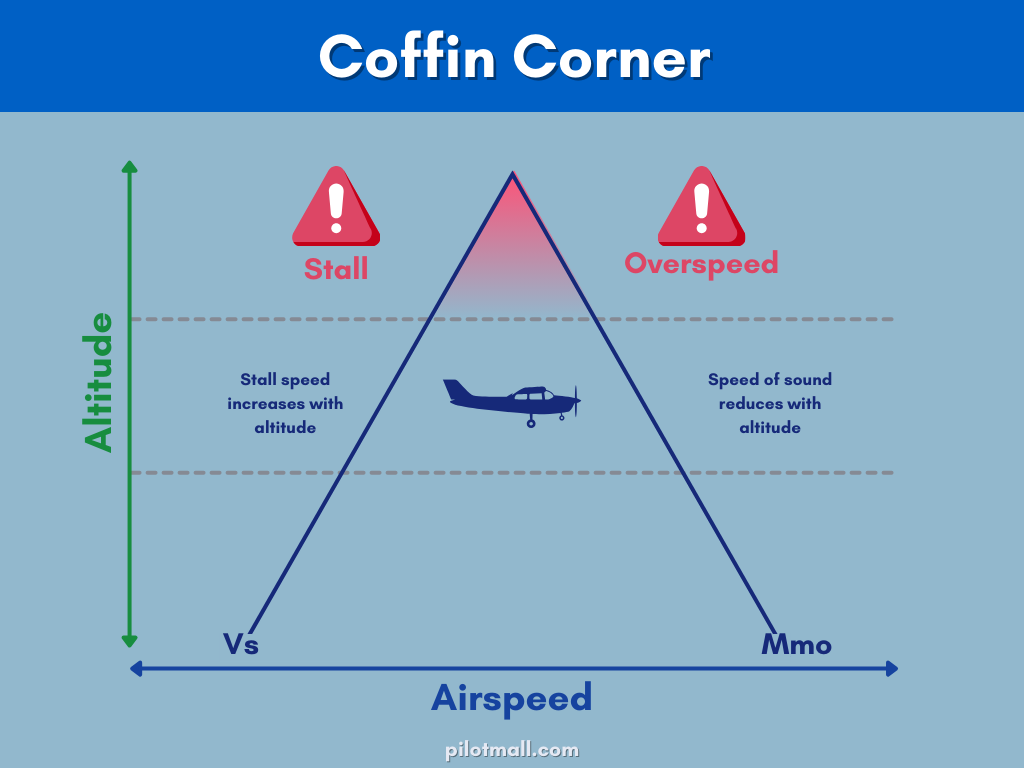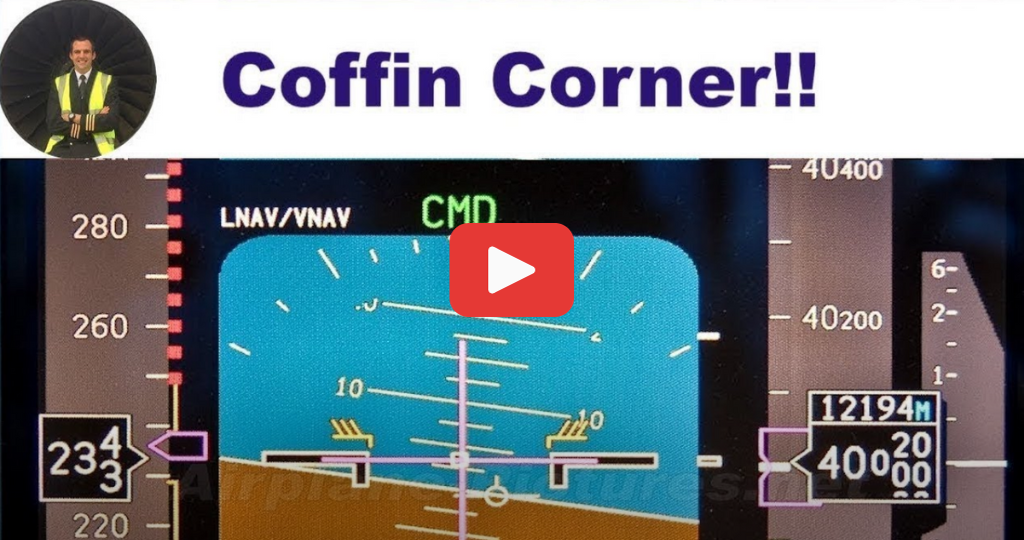Coffin Corner: Reaching Beyond the Limitations
The bearer of an ominous name, "Coffin Corner" sounds eerily spooky, but it need not be. The airplane behaviors within the coffin corner are all governed by several known aerodynamic factors.
Once the interaction between these factors is explained and understood, Coffin Corner becomes much more predictable and navigable for the skilled pilot.

The bearer of an ominous name, "Coffin Corner" sounds eerily spooky, but it need not be. The airplane behaviors within the coffin corner are all governed by several known aerodynamic factors.
Once the interaction between these factors is explained and understood, Coffin Corner becomes much more predictable and navigable for the skilled pilot.
 What is the Coffin Corner?
What is the Coffin Corner?
In Advisory Circular 61-107B, the Federal Aviation Administration (FAA) defines Coffin Corner, or Q-Corner, as it is officially named, as “a term used to describe operations at high altitudes where low IAS yield high True Airspeed (TAS) as indicated by Mach number at high angles of attack (AOA).”
Essentially, the term “coffin corner” identifies the upper limits of an aircraft’s operational envelope when flying at high altitudes (above 25,000 feet). These limits are also referred to as the aerodynamic ceiling and are where stall and overspeed meet.
Since this particular type of aerodynamic ceiling is located at very high altitudes, it is encountered by jet aircraft pilots, rather than pilots of small general aviation aircraft.
 What Makes Coffin Corner Dangerous?
What Makes Coffin Corner Dangerous?
It is difficult to maintain steady straight and level flight in the coffin corner because the margins are very small. An aircraft must stay within a narrow speed range and avoid reaching beyond the limitations because flying too fast or too slow will cause the plane to hit stall speed.
The only way to fly in the coffin corner (Q-Corner) is to maintain a steady true airspeed (TAS) within the narrow parameters which continue to narrow further with higher altitude.

Aerodynamics in Coffin Corner
The two key variables that set up the aerodynamics of coffin corner are true airspeed (TAS) and altitude. These variables can be plotted out on a graph with the horizontal x-axis being the true air speed (TAS) and the vertical y-axis representing altitude.
Remember that while an aircraft will stall at a constant indicated airspeed (IAS), as altitude increases and air density decreases, the true airspeed (TAS) will increase, and the plane will have a higher true airspeed stall or true stall speed. The plotted line of the Vs or true stall speed makes up the left side of our coffin corner graph.
- Maximum Mach Operating Speed (MMO)
The speed of sound varies with temperature and gets slower at colder temperatures. This means that higher altitudes with their colder temperatures translate to a slower speed of sound or Mach speed. The plotted line on the right side of the coffin corner graph depicts the Mach maximum speed that the plane can operate at.
As our graph shows, the narrow operating envelope of coffin corner exists at the peak of the graphed pyramid, bordered on one side by the stall limit and on the other side by the Mach limit.
- Avoid Flying too Fast or too Slow
As the aircraft climbs towards the Coffin Corner the margin between stall speed and the Critical Mach speed becomes smaller. Flying too slow, a pilot will encounter a low-speed buffet and reach the stall speed limit. Flying too fast will result in reaching the Mach limit and encountering a high-speed buffet which again causes air flow separation on the wings and ends in a stall.
While most pilots are familiar with the aerodynamics of a low-speed buffet or stall, the high-speed buffet and Mach limit may be less familiar to some. Aircraft have a speed known as Mach Critical Number or M crit. At this speed, the air over at least one part of the airfoil (usually the top of the wings) is reaching supersonic speeds.
The shock waves generated by the supersonic speeds creates airflow separation and drag. The center of lift also shifts back making the nose of the aircraft want to pitch down as it approaches M crit. The speed just below this is the Mmo or Maximum Mach Number Operating speed, and that speed is just within the right side of our coffin corner pyramid.

Visual learners can benefit from PilotEd’s coffin corner video that helps explain the concept and illustrate the issue with hitting the aircrafts stall speed in this situation. Learn more about coffin corner and other high-altitude flying phenomena in Fly the Wing.
How to Avoid the Coffin Corner
For airliners, pilots need to learn where the flight envelope boundaries intersect and the certification standards of the aircraft they will fly. Make sure that the aircraft is able to maneuver and operate at a minimum of 0.3 gs at the highest ceiling.
Armed with that knowledge they can avoid the dreaded corner and stay within the aircrafts safety margins. Remember—be careful with low speed or high speed when operating within the Q-Corner.
You can find the aircraft's limitations in its flight manual. Make sure to chart your altitude, airspeed, and weight to figure out what speed will cause the warning buffets.
More safety-focused reads to help you avoid aviation disasters:
Did you find this article helpful?
Do you think we missed anything important or made a mistake? Let us know in the comments below!























